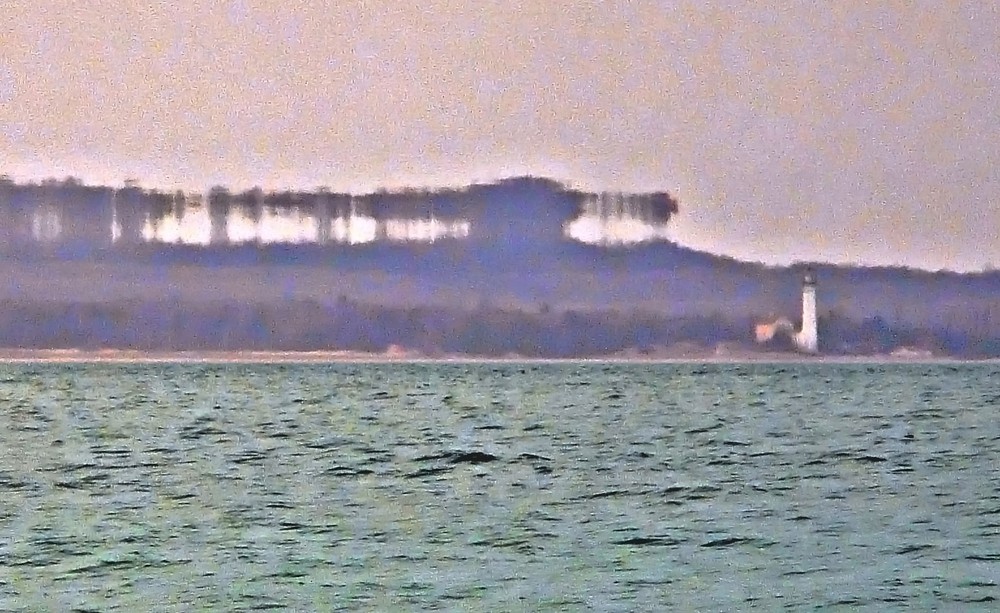The Fata Morgana illusion is a fascinating optical phenomenon that has captured the imagination of many throughout history. It occurs when layers of air at different temperatures bend light rays, creating distorted images that can appear as mirages on the horizon. This captivating display can transform distant objects into ethereal shapes, often resembling castles, ships, or even entire cities. As a result, the Fata Morgana illusion has intrigued scientists, artists, and travelers alike, leading to various interpretations and myths surrounding its occurrence.
Commonly seen over bodies of water or in polar regions, the Fata Morgana illusion has been a subject of both scientific study and folklore. For centuries, sailors have reported seeing ghostly ships emerging from the sea, only to disappear moments later. These enchanting mirages often evoke a sense of wonder and mystery, prompting individuals to ponder the boundaries between reality and illusion. As we delve deeper into this elusive phenomenon, we will explore its scientific underpinnings, historical significance, and the ways it continues to inspire awe in modern times.
In this article, we aim to unravel the mysteries of the Fata Morgana illusion, examining its causes, characteristics, and the various contexts in which it appears. By understanding this optical wonder, we can appreciate the beauty and complexity of our natural world, reminding us of the fascinating interplay between light, perception, and reality.
What Causes the Fata Morgana Illusion?
The Fata Morgana illusion occurs due to a complex interaction between light and atmospheric conditions. This optical phenomenon is primarily caused by temperature inversions, where layers of air at different temperatures create a refractive effect. Here’s how it works:
- Warm air sits above colder air, causing light rays to bend as they travel through the different layers.
- This bending of light can create distorted images of objects that are far away, such as ships or coastlines.
- As the conditions change, so does the appearance of these images, making them appear to shift and morph.
Where Can You See the Fata Morgana Illusion?
The Fata Morgana illusion can be observed in several locations around the world, with some areas more prone to this phenomenon than others. Here are a few notable places:
- The Arctic and Antarctic regions, where cold air meets warmer ocean currents.
- Desert landscapes, where extreme temperature variations occur between day and night.
- Coastal areas, particularly where warm sea breezes meet cooler land temperatures.
How Long Does the Fata Morgana Last?
The duration of the Fata Morgana illusion can vary greatly depending on the atmospheric conditions. Generally, these mirages can last anywhere from a few minutes to several hours. Factors that influence their longevity include:
- The stability of the temperature inversion.
- The angle of the sun and the light conditions.
- The observer's distance from the phenomenon.
What Are the Historical Significances of the Fata Morgana Illusion?
The Fata Morgana illusion has been a source of intrigue and legend throughout history. Many cultures have myths and stories associated with this optical phenomenon. Here are a few notable historical interpretations:
- In ancient times, it was believed to be a sign from the gods, often interpreted as a warning or a guide.
- Sailors referred to it as "the phantom ship," causing confusion and fear among those at sea.
- Artists have drawn inspiration from the illusion, creating works that depict its ethereal beauty and mystery.
Is the Fata Morgana Illusion Related to Other Optical Phenomena?
Yes, the Fata Morgana illusion is just one of many optical phenomena that occur due to the bending of light. Other related phenomena include:
- Mirages: Similar to Fata Morgana, mirages are caused by temperature differences but typically appear as simple reflections on the ground.
- Superior Mirage: This occurs under similar conditions as Fata Morgana but generally presents a more straightforward reflection of objects above the horizon.
- Green Flash: A rare optical phenomenon that occurs just before sunrise or sunset, where a green spot appears on the horizon.
Can the Fata Morgana Illusion Be Captured on Camera?
Yes, the Fata Morgana illusion can be captured on camera, though it can be challenging due to its transient nature. Photographers often seek out ideal conditions, such as:
- Clear skies with low humidity.
- Stable atmospheric layers with significant temperature differences.
- Strategic positioning near large bodies of water.
What Are Some Fascinating Examples of the Fata Morgana Illusion?
There are numerous documented instances of the Fata Morgana illusion that showcase its stunning beauty. Here are a few notable examples:
- Greenland's Icebergs: The illusion has been reported off the coast of Greenland, where icebergs appear as floating castles on the horizon.
- Lake Michigan: Observers have spotted entire cities appearing above the water, creating a surreal landscape.
- The Strait of Messina: This location is famous for sightings of phantom ships, often described in local folklore.
How Can We Experience the Fata Morgana Illusion?
For those interested in witnessing the Fata Morgana illusion, here are some tips to increase your chances:
- Visit coastal regions during early morning or late evening when temperature differences are more pronounced.
- Be attentive to weather conditions that might create temperature inversions.
- Look for flat horizons, such as lakes or oceans, where the illusion is most commonly observed.
Final Thoughts on the Fata Morgana Illusion
The Fata Morgana illusion serves as a reminder of the extraordinary wonders of our natural world. By understanding the science behind this captivating phenomenon and exploring its historical significance, we can deepen our appreciation for the beauty and complexity of light and perception. Whether experienced firsthand or through the lens of a camera, the Fata Morgana illusion continues to inspire awe and curiosity, inviting us to delve into the mysteries of the universe that surround us.




